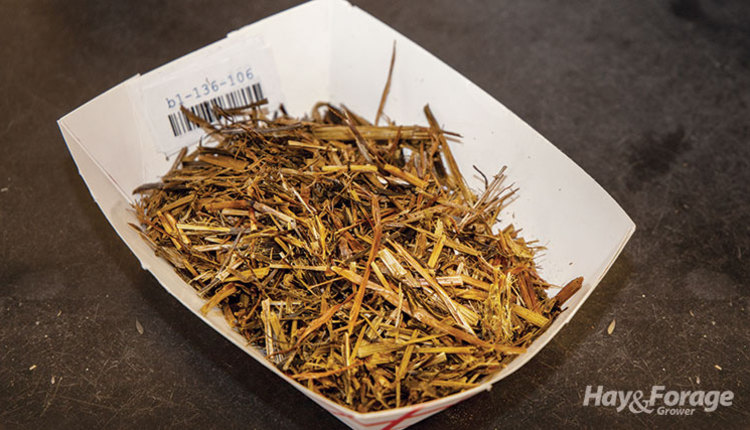The author is the director of nutrition research and innovation with Rock River Lab Inc, and adjunct assistant professor, University of Wisconsin-Madison’s Dairy Science Department.

During nutrition workshops with students and industry professionals, I generally break nutrition analysis training down into sections corresponding to nutrients or nutrient digestion measures. Within the nutrient section, the classifications we discuss include protein, carbohydrates, fat, ash and minerals, and fermentation compounds. Protein and nitrogenous compounds tend to be the first nutrient class we delve into only because these compounds are listed first on most forage and feed analysis reports.
Crude protein is the anchor
Forages tend to be between 5% and 30% crude protein on a dry matter basis. Explained in pounds-per-ton terms, this equates to between 100 and 600 pounds of crude protein per dry ton. With expensive soybean meal and protein prices, this makes protein an incredibly valuable component of forage; however, crude protein is just what the name implies — a crude measure of the actual amino acid and protein content in the forage.
In the feed analysis laboratory, crude protein is determined by measuring the total nitrogen (N) and then multiplying that value by 6.25. Crude protein doesn’t necessarily equate to usable true protein and amino acids in fermented forages, hence a better understanding of nonprotein or bound protein measures in forage crops becomes important.
Nonprotein nitrogen differs
Fresh forages and hay crops tend to have very small amounts of nonprotein-N (NPN), except in cases where nitrate-N is taken up by the plant in considerable quantities, and the living forage is unable to convert this nitrate-N into amino acid and protein fast enough. This situation tends to be associated with extreme drought stress followed by a rain event and harvest, or soon after a killing frost. In both cases, there can be a considerable amount of nitrate-N included in the crude protein fraction; however, this NPN is not true protein and is toxic to ruminants in high amounts, acting like cyanide.
Fermented forages contain a different NPN form from fresh or hay crops. This NPN is measured as ammonia-N and represents broken down protein and amino acid, resulting from fermentation bacteria and microbial protein degradation. Ammonia-N can also result from proteolysis following extensive enzymatic activity.
We can use ammonia-N measures in a couple of practical ways — either to identify an inefficient forage preservation or to assess the extent that corn grain and silage has fermented.
A 10% ammonia-N rule of thumb applies to haylage crops, whereas the goal is to have 10% or less of the total crude protein measured as ammonia-N. Alternatively, this means that 90% of the crude protein has been conserved in protein or amino acid form. When ammonia-N is greater than 10% of the total crude protein, the forage has likely fermented inefficiently and the true protein value of the feed isn’t optimized.
For corn grain and silage, the protein in the feed is of lesser interest relative to the starch and energy component. Silage and high-moisture corn offer exceptional energy per pound due to excellent starch digestibility following ensiling. With these feeds, 10% or greater ammonia-N indicates adequately fermented silage or high-moisture corn, and this implies that the silage or grain is feeding to its full potential.
Bound protein of little value
The final protein fraction laboratory measure is undigestible protein, which is found in the acid detergent fiber-bound fraction. Some protein is inevitably locked within forage fiber. Of particular interest is the protein that is bound so tightly to fiber that even a strong acid detergent can’t break the protein loose. This is defined as acid detergent insoluble crude protein, or ADICP.
With an efficient fermentation or hay preservation and no heat damage, the ADICP should be less than 1% of the total forage. If this value is greater than 1%, there is reason to believe that substantial heating in the ensiling or curing process took place and bound too much protein into an indigestible form.
Hay that heats because it was harvested at too high of a moisture content will often have a high ADICP value, especially if it “caramelizes.” This undigestible protein passes through the animal without providing any value and should be subtracted from the total crude protein when balancing diets.
Looking toward the future of animal nutrition, we’ll likely progress toward amino acid measurements as a more accurate depiction of the true protein content in feeds. However, for the immediate future, the crude protein, nonprotein nitrogen, and bound protein measures remain the bedrock for dairy or beef nutritionists to formulate diets.
Next time you review your forage analyses, identify and interpret the protein measures discussed here. In following “Feed Analysis” columns, we’ll cover the other sections with a goal to advance your feed analysis report interpretive skills.
This article appeared in the August/September 2022 issue of Hay & Forage Grower on page 28.
Not a subscriber? Click to get the print magazine.

